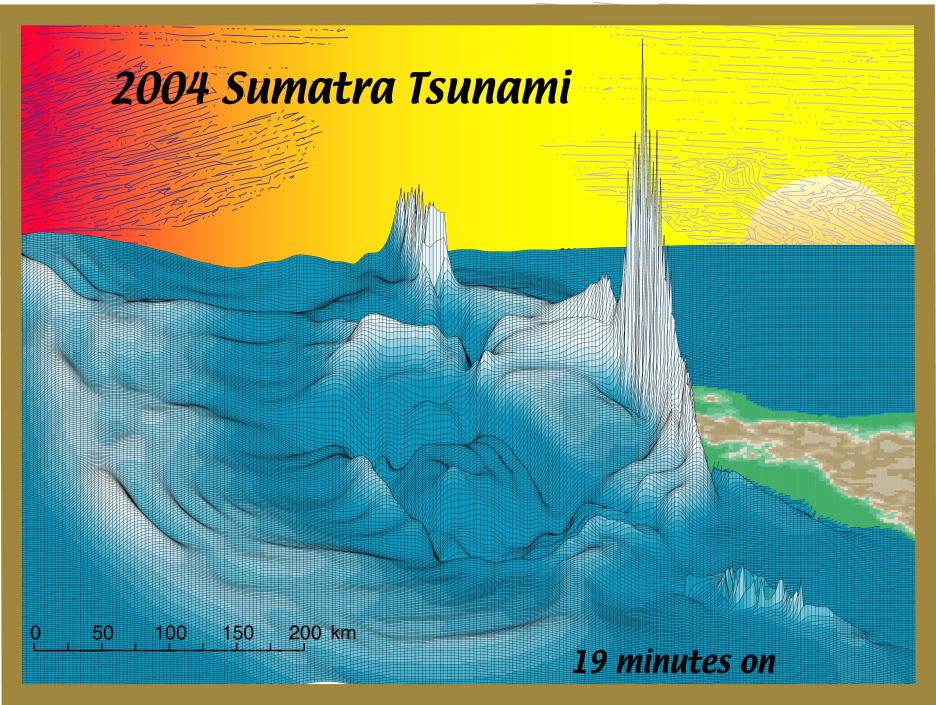Sharing science in the days of YouTube
Steven Ward has a pretty good trick. He can drop you right into the heart of a natural disaster and you’ll come out unscathed.
Guaranteed.
Tsunami? Earthquake? Volcanic explosion? He’ll even take requests.
Ward creates computer simulations of natural disasters, like hurricanes and landslides, and posts many of his videos to YouTube.
“You see stuff sliding down a hill and going around bends,” says Ward a geophysicist at the University of California, Santa Cruz. “People like it.”
But these images of falling rock and crashing waves aren’t cartoons. The simulations are based in physics and mathematics, and Ward hopes that scientists, students and the public will find them useful.
“Think of all the people that teach disaster courses or geology,” says Ward. “Students need some visuals.”
While his videos can’t compete with Justin Bieber on YouTube, Ward’s most watched disaster has gotten over 50,000 views.
He estimates that his YouTube channel gets about 600 clicks every day. That’s pretty impressive for videos that are sprinkled with data on wave speed and heights and show the complex movements of landslides.
“There’s forces, stresses, friction and gravity; all these things are really in there,” says Ward. “If you’re an expert, there’s numbers on all the graphs too.”
[youtube=http://youtu.be/-KaMttI3fk0&w=320&h=240&rel=0]
Ward has been creating these simulations for decades as part of his research in modeling natural disasters. But when he bought a new computer installed with iMovie a few years ago, the video-editing software gave him the option to post to YouTube.
“I didn’t know anything about YouTube three years ago,” says Ward. But he decided to give it a try.
Since then, the physics-based simulations have evolved into short movies about some of the natural disasters of our past, complete with old, black and white photographs, historical maps, local records, and storytelling.
“Sometimes science gets a little abstract, so you do something that’s real once in a while,” says Ward, who thinks the extra dose of history draws people in.
The videos allow his YouTube audience to travel back in time to watch a volcano explode or a dam burst. They learn a little about physics along the way.
“I get some emails like ‘my great grandfather died in this flood,’” says Ward. But “the best ones are from people who say, ‘I never thought much about this but I liked your video.’”
[youtube=http://youtu.be/tMc9kP9q-d8&w=320&h=240&rel=0]
High school students and geology majors have included his videos in class projects and presentations.
Ward even hears from music students, who compose scores to accompany the visuals. It’s a simple addition because Ward’s movies are silent. The old photos and geophysical simulations are interspersed with captions explaining the events.
People have asked if Ward will ever add sound but he says no. He enjoys the “creepy” silence.
Ward also uses video to make predictions about the future. He’s been asked to create simulations on what would happen if a tsunami hit Santa Cruz, New York City, or the San Francisco Bay Area.
[youtube=http://youtu.be/BELavEvImYo&w=320&h=240&rel=0]
Not all of Ward’s videos are up on YouTube. A complete list of over 60 models are found on his website and my favorite there is a simulation showing an asteroid crashing into the Atlantic Ocean. Waves hundreds to thousands of meters high erupt from the epicenter rippling outwards and pummeling the continental coasts.
From the safety of your computer, you can watch the epic disaster as many times as you like.
